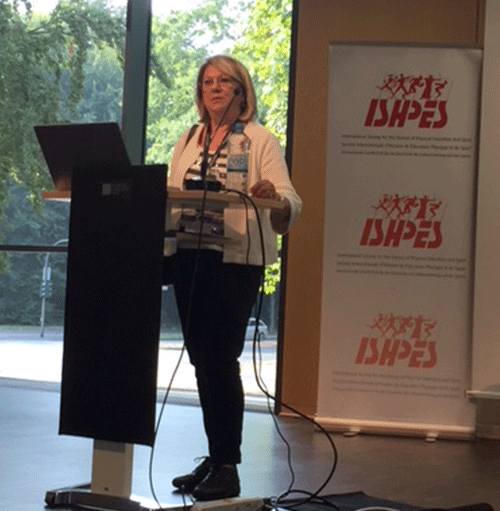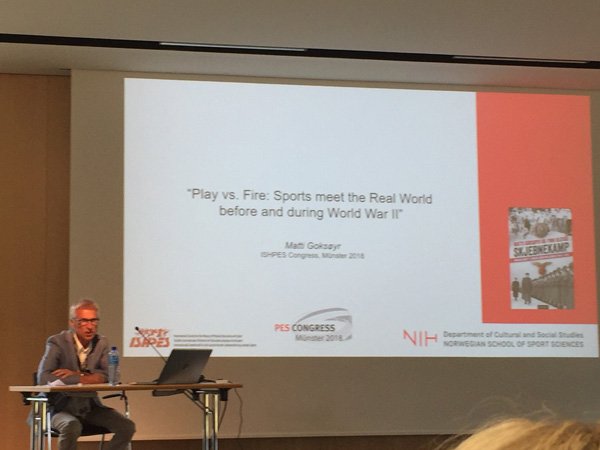Longtime ISHPES member and former council member and vice president Gigliola Gori presented the Routledge Keynote at the 2018 Congress in Münster, Germany. Gori’s talk was entitled “Sporting Propaganda in Visual Arts under the Fascist Regime and the Example of the 1941 Cremona Prize”.
Gigliola Gori’s first degree was from the National Academy of Dance in Rome, followed by an MA degree in Physical Education and Sport, and MA degree in Sociology from the University of Urbino, Italy, and then doctoral work at the University of Göttingen, Germany. Dr Gori has had an extremely distinguished career as Professor for the History of P.E. and Sport and the History of Pedagogy, in the Faculty of Sport Sciences at the University ‘Carlo Bo’ of Urbino. Her research has covered a wide range of interests including Etruscan sports; dances and games of the Middle Ages; Italian women’s sport in the 19th century; Futurism and sport, and Fascism and sport. She has 5 books (in both Italian and English) and an equal number of edited volumes as well as many research articles, chapters and conference presentations. Indeed her contributions to sport history, through fine-tuned research about Italian sport, especially around gender and politics, has been enormous and extremely valuable. She is also a former vice-president of ISHPES and co-founder and fellow of CESH and she has lent a steady support and fertile mind to these organizations over many years. Her graciousness and generosity are unparalleled and ISHPES is extremely honoured to present her the 2018 Routledge award for her many contributions to the history of sport and culture.
ABSTRACT
Starting as early as 1933, German Nazis had attempted to eradicate so-called entartete Kunst (Degenerate Art), their counterparts in Fascist Italy had long allowed artists relatively free reign to express their creativity so long as they adhered to European or national norms. However from 1936 onwards events such as the victorious war in Ethiopia, the proclamation of the Italian Empire and the declaration of the Rome- Berlin Axis followed by the “Pact of Steel” in 1939 caused Italy to be drawn into Hitler’s sphere of influence. These events encouraged such measures as promulgating the odious racial laws and Italy’s increased militarization. Even art and culture had to be reconsidered in order to conform more closely to Nazi ideals promoting the pure Aryan race.
Thus while Germany mounted major artistic events such as the Große Deutsche Kunstausstellung (Great Exhibition of German Art) which was held annually from 1937 to 1943, Italian artists (both professional and amateur) produced works of “militant art” that followed official propaganda in line with Nazi tastes and principles. These artworks were shown regularly at local and regional events, and the best works were selected for the Premio Cremona (Cremona Prize), a national contest which aimed to popularize “militant art.” At the same time, Italians wanted to develop artistic originality, so the Premio Bergamo (Bergamo Prize) was also offered; this competition sought to be more open to new artistic ideas and was much less influenced by German prototypes.
From the inception of his government, Mussolini showed that he was a master of propaganda and with it he promoted public health and supported physical education and sport both in school and during free time. In this way Fascists hoped to endow citizens with strength, courage, discipline and determination, and in this way they could be ready to “believe, obey and fight” for the greatness of the Fatherland. Consequently, the visual arts often displayed athletes engaged in different physical activities; the works are frequently done in either the classic style, the “militaristic” Nazi mode or in the style of Futurism which remained very popular throughout the twenty-year span of Fascism.



